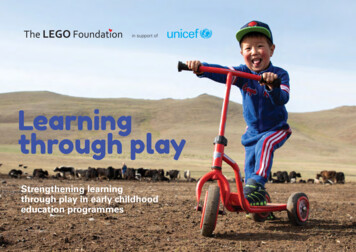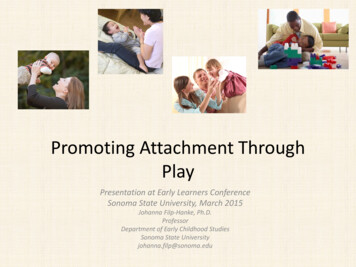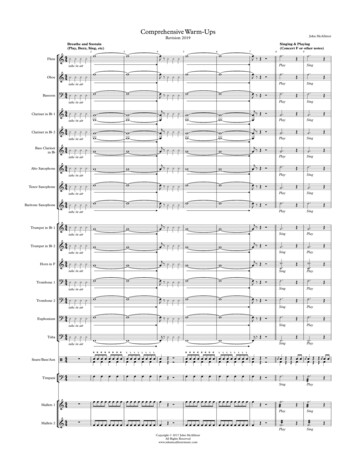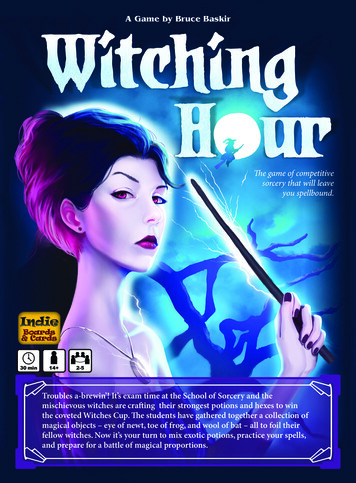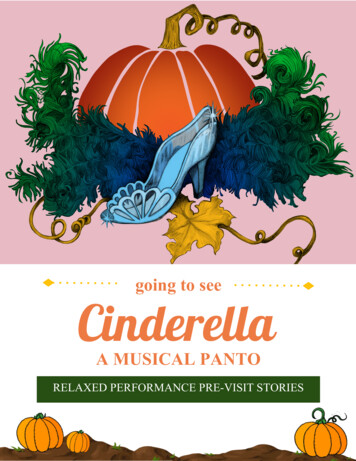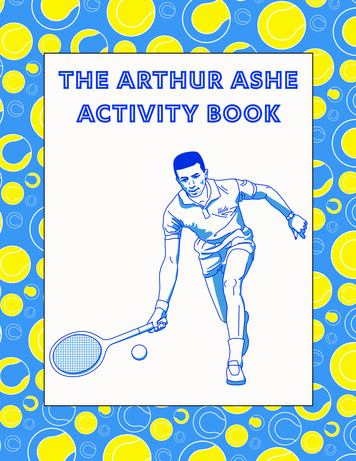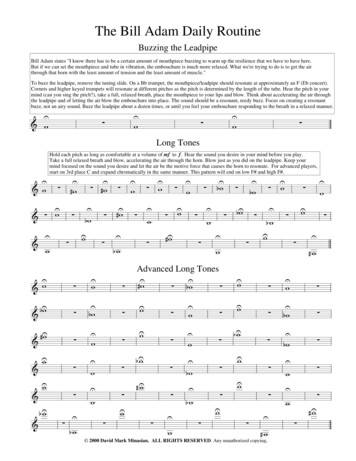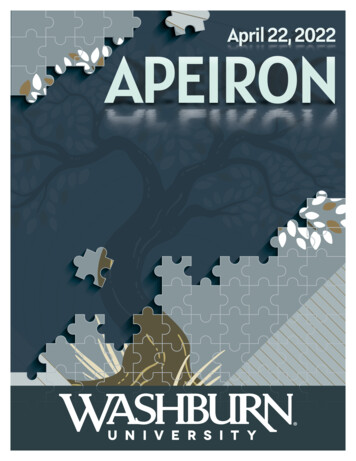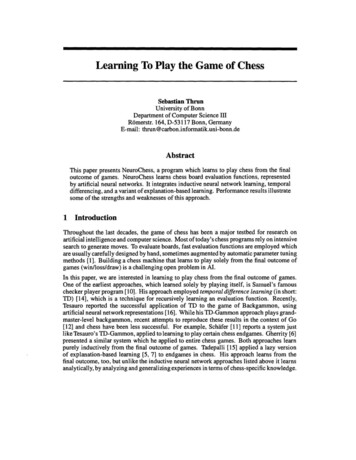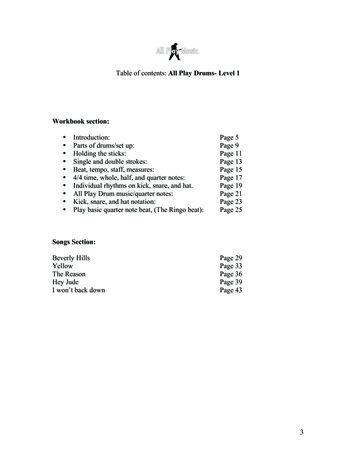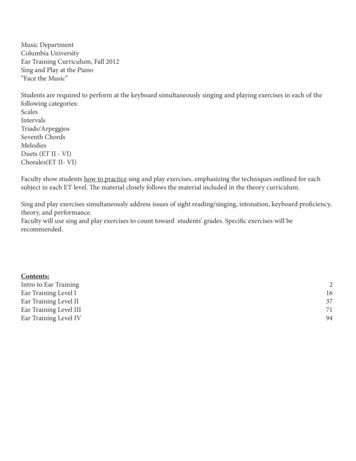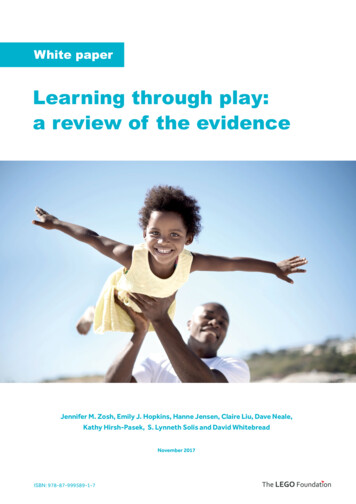
Transcription
White paperLearning through play:a review of the evidenceJennifer M. Zosh, Emily J. Hopkins, Hanne Jensen, Claire Liu, Dave Neale,Kathy Hirsh-Pasek, S. Lynneth Solis and David WhitebreadNovember 2017ISBN: 978-87-999589-1-7
Table of contentsExecutive summary 3Thriving in the 21st century 4Learning is broad, interconnected and dynamic 8Children are born to learn through play 12Characteristics of playful learning experiences 16Joyful 18Meaningful 20Actively engaging 22Iterative 24Socially interactive 26Future directions and unanswered questions 28Closing thoughts & acknowledgements 32About the authors 33References 34This white paper is published in 2017 andlicensed under a Creative Commons AttributionNonCommercial-ShareAlike 3.0 Unported sa/3.09)ISBN: 978-87-999589-1-7Suggested citationZosh, J. M., Hopkins, E. J., Jensen, H., Liu, C., Neale, D.,Hirsh-Pasek, K., Solis, S. L., & Whitebread, D. (2017).Learning through play: a review of the evidence (whitepaper). The LEGO Foundation, DK.
Executive summeryExecutive summaryThe aim of the LEGO Foundation is to build a futurewhere learning through play empowers childrento become creative, engaged, lifelong learners.This ambition is more critical than ever. The worldof today and tomorrow is one of challenges butalso of tremendous opportunity. An increasinglyinterconnected and dynamic reality means childrenwill face continuous re-skilling and a need for lifelonglearning as they grow. Many children also facehardship in the shape of stress, poverty and conflict.They need positive experiences and coping skills tocounterbalance negative factors in their lives, andsupport their confidence and opportunity for making adifference. We firmly believe that promoting children’sdrive to learn, their ability to imagine alternatives, andto connect with their surroundings in positive ways, isabsolutely essential.This white paper summarises current evidence onthe role and importance of children’s learning throughplay. We first consider what it takes to thrive in a 21stcentury context, before defining learning in a broadsense: both as a deep understanding of content and aslearning-to-learn skills that build on children’s naturalaffinity to learn and engage with their world from birth.We then draw on the science of effective learning,rigorous play research and neuroscience to explorethe potential of playful experiences for promotingdeeper learning and a breadth of skills. We outlinewhat evidence is known, what gaps exist, and proposefuture directions for research. The three boxes belowsummarise these insights under three headlines: whatwe know, what we think and what needs to be done.Through active engagement withideas and knowledge, and also withthe world at large, we see childrenas better prepared to deal withtomorrow’s reality - a reality of theirown making. From this perspective,learning through play is crucial forpositive, healthy development,regardless of a child’s situation.What we knowWhat we thinkWhat needs tobe doneLearning through playLearning through playLearning through playhappens through joyful,supports overall healthyresearch across culturesactively engaging,development, acquisition ofmeaningful, iterative,both content (e.g., math) andWell-controlled studiesand socially interactivelearning-to-learn skills (e.g.,examining play’s role forexperiences.executive funtion)higher-level skillsOur goal is to developThe benefits and role ofGreater understanding ofcreative, engaged, lifelonglearning through play differhow play and its benefitslearners who thrive in a 21stacross contexts and cultureschange over time and contextcentury worldInsights from neuroscienceon play in real-life contexts3
SchoolCommunity“HomeLearning through play is aboutcontinuity; bringing togetherchildren’s spheres of life - home,school and the wider world, anddoing so over time.Susan MacKay,Director of Teaching and Learningat Portland Children’s Museum
Thriving in the 21st centuryThriving in the 21st century:challenges and opportunitiesToday’s children (tomorrow’s adults) grow up facing rapid change, globalchallenges, and connectivity, all of which affect their prospects of life and work.The LEGO Foundation aims to build a future wherelearning through play empowers children to becomecreative, engaged and lifelong learners. UNESCO usesthe term global citizenship to highlight this need forempowering children to take active roles in the face ofglobal challenges and to become contributors towardsa world characterised by greater peace, toleranceand inclusion (UNESCO, 2015). Their call to actionalso reminds us of a difficult reality; all over the world,children face hardship. Neglect, loss, poverty andconflict are just some of the situations where they areat risk. They need protective experiences and copingskills to counterbalance negative factors in their lives(NSCDC, 2015). In this white paper, we focus on threespecific potentials for learning through play: duringchildren’s development in the first years of life, throughentering school age and laying the foundation forlifelong learning.Play in early developmentNeuroscience presents us with strong evidence forthe profound influence of early experiences. In orderto build healthy brain connections from the outset,young children need responsive and rich socialinteractions with caregivers, combined with sufficientnutrients and an environment free of toxins (CDCat Harvard University, 2016). Playful experiencesoffer a unique context for these supportive and richlearning experiences in early childhood (see also theforthcoming white paper titled Learning through Play inthe First 1000 Days by J. Robinson, in progress).Connecting play and educationAs children grow, preparing them for the demands ofschool and the wider society is key. However, contentonly serves children as far as they can apply and buildon it: a child who has not grasped the concepts ofplus and minus stands little chance of understandingequations. Attaining key content and facts is importantfor school and life, but children also need a deep,conceptual understanding that allows them to connectconcepts and skills, apply their knowledge to differentsituations, and spark new ideas (Winthrop & McGivney,2016; Frey, Fisher, & Hattie, 2016). We see playfulexperiences as optimal for engaging in this type ofdeeper learning (see the section on ‘Characteristics ofplayful experiences’ in this white paper).Play and lifelong learningFinally, today’s world is uncertain and constantlychanging – from shifting career and politicallandscapes to increasingly digital economies and sociallife. New technologies mean we live and work in waysthat did not exist twenty years earlier. Children needskills and mindsets allowing them to step into thisuncertainty, create opportunities for themselves andtheir communities, and learn throughout life. Using thesimple, yet compelling words by researchers Golinkoff& Hirsh-Pasek (2016), realising children’s potential inthe face of this uncertainty means supporting them tobe “happy, healthy, thinking, caring, and social childrenwho will become collaborative, creative, competent,and responsible citizens tomorrow”.5
Thriving in the 21st centuryWhat global citizenship, coping and thriving looklike for children may differ dramatically across time,culture, and context, but the deep understanding thatcomes from effective learning experiences will nodoubt be an important step. In playful experiences,children tap a breadth of skills at any one time. Whenplaying together, children are not just having fun butare building skills of communication and collaboration.A game of hide-and-seek helps them to managefeelings about the unknown while also helping them tothink about what other people know and see. Beyondenjoyment, playful experiences have the potential togive children the skills they will need in the future thatgo beyond facts. As we discuss more fully below, playfulexperiences appear to be a powerful mechanismthat help children not only to be happy and healthy intheir lives today but also develop the skills to be thecreative, engaged, lifelong learners of tomorrow.“In the following sections, we present insights fromdiverse scientific literatures to describe the nature ofchildren’s learning and the role of play and agency intheir development. This leads to five characteristicsthat describe the interface between play and learning:joyful, meaningful, actively engaging, iterative andsocially interactive. This evidence base offers a broad,yet compelling picture of how playful experiencessupport children’s development and learning,particularly in the early years of life. Yet, we alsorecognise that more work is needed to discover themechanisms by which child play engages with learningoutcomes, and what happens as children grow older.In the closing remarks of this white paper, we pointto future directions and unanswered questions onlearning through play.We don’t teach uncertainty inschools. It should be the absolutebedrock of what we teach children– how we come to know and how wedescribe reality. In fact, we teachthe exact opposite.Adam Rutherford, science writer,& Rufus Hound, comedian6
Learning is broad, interconnected and dynamicLearning is broad,interconnected and dynamicLearning is sometimes thought of in the strictly cognitive or academic sense,yet research in child development has shown us that learning is much broaderand interconnected.A holistic view on learningNewer approaches to theory and practice have donean excellent job of extending the view of learning toinclude areas such as physical (e.g., fine and grossmotor skills), social (e.g., empathy and theory of mind),emotional (e.g., development self-regulation and evenself-conscious emotions), and creative development(e.g., divergent thinking, making and expressing). Thisbroad view of learning is a tremendous step forwardin our understanding. However, some still view thesedifferent domains as separate from each other. Sucha view fails to capture the real nature of learning-tolearn and particularly the skills required in learning tolearn that truly allow children to be prepared for 21stcentury opportunities (Golinkoff & Hirsh-Pasek, 2016).We see the shortcomings of this domain-basedmodel in two ways.Child development is interconnectedFirst, research in the last few decades has repeatedlyshown that the different domains of development arenot silos as much as they are interconnected gears:development in one area can influence developmentin another. For example, physical development laysthe foundation for later cognitive and social skills. Awhole new world opens to a toddler who learns to walkinstead of crawling. Now, he can hold a toy with easeand go in search of his caregiver, gaining access tonew interactions, language and play (Karaski, TamisLeMonda, & Adolph, 2014).8Social competence and emotion regulation in turnunderpin children’s cognitive skills (McClelland, Acock& Morrison, 2006), and language helps children interactwith peers in positive ways (Vallotton & Ayoub, 2011).Studies looking across the span of childhood find thatinfants who are more physically active and exploremore at the age of 5 months show more success inschool at age 14 (Bornstein, Hahn, & Suwalsky, 2013).These examples highlight that children’s growth anddevelopment is beautifully complex and not easilybroken down into neat divisions. Importantly, lessonsfrom neuroscience also tell us that learning is dynamicand not easily divisible into separate and independentmental processes (e.g., Bassett et al., 2004; Dahaene,2009; Sporns et al. 2004; Wandell, Rauschecker, &Yeatman, 2012).Learning-to-learn skillsSecond, if we think about development as fitting intoneat domain-based divisions, we lose sight of thecrucial learning-to-learn skills that cut across domainboundaries (Golinkoff & Hirsh-Pasek, 2016). Trulylearning information and new skills requires a dynamic,deep, conceptual understanding that often relies uponall of those domains. For example, executive function- a suite of abilities that includes working memory,the ability to inhibit impulses, and switch attentionbetween tasks or rule sets - has been shown to relateto a variety of academic skills including math andliteracy. Some studies have even found that children’simpulse control in preschool predicts a wide range ofoutcomes in adolescence and adulthood, includinghigher SAT scores, better health, and lower rates ofsubstance abuse (Mischel et al., 2011).
Surface learningmeans wememorise keyfacts and principlesA hexagon hassix straight sidesand six anglesA triangle has threestraight sides andthree angles – the sumof its angles is 180ºDeeper learningallows us to connectfactual knowledgewith real-worldexperiences andreally grasp theirimplicationsIf you make a triangle out ofthree sticks with hinges in thecorners, it stays rigid. That’s whytriangles are used in bridges,cranes, houses and so on.Notice how snowflakes aresymmetrical hexagons?This shape reflectshow the crystal’s watermolecules are connected.Hexagons are useful shapes,for example in beehives.They use the least amountof wax to hold to mostweight of honey.
Learning is broad, interconnected and dynamicLearning-to-learn skills encompass a wide variety ofabilities that help children learn information, acquireskills, and deal with new situations (e.g. Care, Kim,Anderson, & Gustafsson-Wright, 2017; Deci & Ryan,2000; 2012; Dignath, Buettner, & Langfeldt, 2008;Harvard CDC, 2011). They include the ability forchildren to be motivated drivers of own experiences.This involves focus and attention to avoid distractionsthat pop up, the curiosity and motivation to seek outnew opportunities and information, the willingness totake risks, have confidence, and have a love of learning.Additionally, children benefit from having the skillsnecessary to be a self-starter - namely autonomy,persistence, and goal setting - and the ability to riseto meet new challenges. This requires imagininginnovative and creative solutions to problems andadapting those solutions if the first try fails.out hypotheses, and reason critically and scientificallyabout evidence. We must also think about how bestto prepare children to think in this critical, scientificway. Finally, we cannot ignore the fact that we live in asocial world, and to succeed in life children must havethe ability to interact and work with other people.Young children need to not only understand andregulate their own emotions but also express thoseemotions effectively and to understand and empathisewith others. Beyond communication, the ability toeffectively work with other people to accomplish goalsis critical. Children and adults are more successfulwhen they can communicate their ideas to others,collaborate to accomplish joint goals, negotiate whenpartners disagree, and take leadership when necessaryto help move a team forward (Jones, Greenberg, &Crowley, 2015).When children develop the ability to explore theirenvironment, be resourceful about the materials,people, and skills that they engage with, and thinkflexibly about different approaches to a situation,they are better equipped for whatever challenge nextconfronts them. Many problems will also require theability to isolate important aspects of a situation, testImportantly, these kinds of skills not only build uponthemselves, but also upon one another in a dynamiccycle of development. Let’s imagine two childrenbuilding with blocks, and one decides to knock theother’s tower down. In this situation, the tower-buildermust try to control the negative emotions this actioncauses. In building this emotional regulation, the childHow do we build these important skills for the future?Research suggests that playful learning experiences appear to be a particularly effectivemechanism for the development of these broad, dynamic, and interconnected skills (termed “the6 C’s” by Golinkoff & Hirsh-Pasek, 2016). Imagine a group of neighbourhood children playing ona playground. These children are pretending to be part of a family, with different children takingon different roles in the family - the parents, the siblings, even the family pet! At first glance, thisappears to be a simple game of pretend. But when viewed through the lens of playful learning,we see that children are actually building much more than a pretend family. As they negotiateroles, they are building the skills of communication and collaboration. As they look around for newmaterials to incorporate into their pretend reality, the are exhibiting creative innovation (e.g., abicycle turned upside down becomes an ice cream truck). As the younger ones begin to questionthe ‘rules’ imposed by the older children, they are practicing their critical thinking skills. As they allbegin to act out things outside of their comfort zones, they are building confidence in themselvesand their ability to face new challenges. Finally, even content knowledge is being strengthenedthrough increased exposure to language and even math as they pay the ice cream seller with their“currency” (e.g., sticks). These are the same skills that will help children to become successfuladults and are reviewed in the rest of this piece.10
Learning is broad, interconnected and dynamic“Content is not learnable ifcommunication skills are not inplace, and critical thinking operateson content, not in a vacuum. Inthis way, the skills build on andreinforce one another.Rebecca Winthrop & Eileen McGivney,Center for Universal Education, Brookings Institutionis now better prepared to interact more effectivelywith others in similar circumstances; equally, she isbuilding the skills that will help her to control her fearduring a doctor’s visit or her sadness when a parentleaves for the evening. In this way, play experiencescan help children to exercise those same skills insafe contexts and extend them to more challengingsituations.By highlighting a breadth of skills, the idea is not tolose sight of content. In fact, the two are sides of thesame coin. For example, critical thinking and reasoningis easier when one has knowledge of the context ofa problem (see Willingham, 2006) or can think of theproblem in terms of information that is personallyfamiliar. Ingenuity often depends on knowing howsomething is currently done and looking for waysto make it better (DeHaan, 2009). In short, learningcontent is critical because the more you know, themore you are able to learn. Children can learn contentdirectly, for example when taught about scientificdiscoveries in school or reading a picture book aboutanimals with a caregiver. In these cases, the content ispresented directly to them. The point is, however:New information is learned betterwhen it connects to and expandswhat we already know.See Willingham (2009) for a discussion and thesection on meaningfulness in this paper. Learningexperiences can also build up the learning-to-learnskills that allow children to find relevant contentthrough their own efforts. It is important to cultivateboth paths, and playful experiences provide a contextthat can support both. In the next section, we presentinsights from research on how children learn best both skills and content.11
Children are born to learn through playChildren are born to learnthrough playThe tools for enhancing and strengthening children’s learning are already available in ourhomes, communities, and classrooms. The answer is, in essence, as simple as child’s play.From the first moments of lifeChildren possess an amazing, natural potential tolearn. Infants as young as a few hours old prefer tolisten to the sounds of human voices over any othersound (Vouloumanos & Werker, 2007) and younginfants have even been referred to as “scientists inthe crib” (Gopnik, Meltzoff, & Kuhl, 1999) due to theirnatural curiosity and drive. Beyond more obviousareas, such as language development and motorskills, young children also have an imagination andinventiveness that helps them create new ideas andopportunities, and a strong motivation to connect andengage with others. Play harnesses and builds on thispotential. From pretending to discover a new country inone’s own backyard to hours spent building the world’slargest train-station, there is no doubt that play andchildhood go hand-in-hand. In the past few decades,research has repeatedly shown that play experiencesare not merely fun, nor just a way to pass the timealong the way to adulthood. Instead, play has a centralrole in learning and in preparing you for challenges lateron in childhood and through adulthood. In the nextsection, we will explore the characteristics of play thatlead to deeper learning - ultimately preparing childrenfor handling unforeseen events and taking advantageof opportunities in their lives in the 21st century.12Play is natural and necessaryFrom vocal play in human infants to play observedin other animal species such as rats, non-humanprimates, and dolphins, play seems to be a naturalinclination across the animal kingdom and helpindividuals within a species to learn, grow, and thrive(Pellegrini, Dupuis, & Smith, 2007). Extreme cases,where infants were raised in deplorable conditions(Bos, Fox, Zeanah, & Nelson, 2009) or experimentalmanipulations where rats and mammals were raisedwithout play (Spinka, Newberry, & Bekoff, 2001)have shown that play is not simply a ‘bonus’. Rather,play has a key role in healthy, positive development.Although natural, play must also be supported by theenvironment. A report from the American Academy ofPediatrics highlights the need and importance of playfor promoting healthy child development, especiallyfor those children living in poverty whose access tosafe, playful experiences may be lacking (Milteer,Ginsburg, The Council on Communication and Media,& Committee on Psychosocial Aspects of Child andFamily Health, 2012).
Children are born to learn through playA continuum of playful learningGenerally, the literature conceptualises play as existingalong a continuum. At one end, free play gives childrenthe freedom to explore, play, and discover withminimal constraints. But play is not just something thathappens in a vacuum: our environments structure play(e.g., the materials available when playing in a home, ina yard, in urban environments, in rural environments,etc.) as do the peers, adults, and other people aroundus. And so, at the other end of the continuum is playthat is more guided or structured. The term “playfullearning” is an umbrella term that is used to includefree play as well as these more structured, guided playcontexts (see figure below). Additionally, researchershave recently added games under this umbrella(Hassinger-Das, Toub, Zosh, Michnick, Hirsh-Pasek,& Golinkoff, 2017). Playful learning can take manyforms, including physical games such as hide andseek, construction play with blocks, board games,pretending with objects, or engaging in fantasticalrole play (see the literature review on play types andchildren’s development by Neale, Whitebread et al.,2017). Although there is ongoing debate in researchand practice about where free play ends and moreguided play begins (e.g. Pyle & Danniels, 2017), our goalin this piece is not to resolve this theoretical debate.Instead, we maintain that learning through play canhappen through free play and when adults or aspects ofthe environment structure the play situation towards aparticular learning goal.Playful learningFree playchild-ledGuidedplaychild-led, adultscaffoldedGamesAdult designed/scaffoldedSet rules and constraintsfor playDirectInstructionAdult designed/controlledSet constraints for activityBalance of child-adult involvement and constraints13
Children are born to learn through playThe importance of child agencyWhether adults are supporting or not, a criticalrequirement for learning through play is that childrenmust experience agency and be supported ratherthan directed. Anyone who has spent time with an18-month-old knows just how much children like totake control. Whether it is putting on her own shoesor feeding herself despite lacking fine motor skills, ahallmark of toddlerhood is the idea of the self as anagent. This quest for control, initiative, and, in a way,leadership, does not end with toddlerhood however.Indeed, the challenge of balancing a child’s own desireswith the reality of rules, social norms, and situation hasbeen at the heart of many psychological theories. FromFreud’s id, ego, and superego to Erikson’s psychosocialstages of development, the idea that children have adrive for at least some degree of agency is prevalentboth anecdotally and theoretically. Having agency doesnot equal ‘anything goes’ for children either at home orin education contexts. Agency in learning through playmeans seeing the child as capable rather than a blankslate to be filled (Daniels & Shumow, 2003).Agency is about the balance of initiative in the childadult relationship: are children’s interests listened to?Are they consulted on decisions that concern them?Do they initiate an activity and invite adults to jointhem in play and decision-making? In other words,what opportunities do children have for exerting theirthinking and actions in a social context where othershold the same rights? Two dimensions may be helpfulto consider: how planned the learning environment is,and how much the child and adult control the evolving‘flow’ of activities (Sinclair, 2004; Toub, Rajan, Golinkoff,& Hirsh-Pasek, 2016; Cheng, Reunamo, Cooper, Liu, &Vong, 2015).14Imagine a teacher arranging creative centres in theclassroom. In one corner, children cut cardboardowls from a template; in another, they choose andcolour print-outs with a shape - triangles, squares, orcircles; in the third corner, children work together tobuild a city from wooden blocks. On the surface, allchildren are busy doing a task with creative materialsbut they have different degrees of choice: from nonewhen they are cutting out templates to at least somewhen choosing and colouring shapes. The greatestopportunities for flexing their ‘thinking muscles’ comewhen they are allowed to create and develop a cityfrom their own idea to a final product. Likewise, we canpicture a two-year-old with her dad, trying to solve apuzzle. In one scenario, the dad hands over the puzzlepieces, one by one, and indicates where to place eachpiece. In this case, he controls almost all aspects ofthe activity. Alternatively, he might support her towork on the puzzle herself, but occasionally makesuggestions, such as rotating a piece if it doesn’t fit atfirst or trying to look for similar colours. Researchersfind that this kind of scenario, where caregiversensure that children play an active role in solving aproblem-solving task, promotes children’s executivefunctions - that crucial suite of skills used in goalsetting and flexible thinking (Matte-Gagné, Bernier, &Lalonde, 2015; Hammond, Müller, Carpendale, Bibok,& Liebermann-Finestone, 2012).Benefits for developmentThe importance of agency and self-directednessand their impact on learning for humans across thelifespan is, in fact, widely researched. From the workon self-determination theory (Ryan & Deci, 2000) andintrinsic motivation with adults (Cordova & Lepper,1996), the literature is full of examples in which choiceand a sense of agency in determining what is learnedappears to be a powerful mechanism. Even beforeadulthood, seeing oneself as an agent has beenlinked with learning. Infants who are given experiencewith grasping objects themselves are better able to
Children are born to learn through playunderstand the mental states (such as intention anddesire) that underlie actions of others (Sommerville,Woodward, & Needham, 2005). As children beginto move through the world on their own instead ofbeing carried or pushed in a stroller (and thus, have ahigher degree of agency), we see widespread benefitsto cognition. According to Campos and colleagues(2000), “.the onset of locomotor experience bringsabout widespread consequences, and after infancy,can be responsible for an enduring role in developmentby maintaining and updating existing skills.” (p. 150).For example, elementary school children who areallowed choice about the features of a game are moremotivated to play and learn more from it (Cordova &Lepper, 1996).Play is an agentic learning contextPlay captures many of the features that we know fromresearch lead to deeper learning, and thus providesan optimal environment to develop the skills andknowledge that children need to thrive and succeedas adults. Children are intrinsically motivated toplay, which makes it fertile ground for learning anddeveloping new skills. During play, children can takecharge, making choices about what they do andhow. Play can be a highly social activity, allowing foropportunities to learn from and about others. Thus,play can provide many opportunities for learning, butnot all play is learning, and not all learning is play. Next,we describe five characteristics that specifically defineplayful learning experiences and review evidence onhow these link to children’s deeper learning.15
Characteristics of playful learning experiencesCharacteristics of playfullearning experiencesWhat does it look like when children learn through play? On the next pages, we diveinto five characteristics of play with insights from research on how they promotedeeper learning.Regardless of whether a play activity falls closer to freeplay, guided play or games on the continuum, we saythat optimal learning through play happens when theactivity (1) is experienced as joyful, (2) helps childrenfind meaning in what they are doing or learning,(3) involves active, engaged, minds-on thinking (4)involves iterative thinking (e.g., experimentation,hypothesis testing), and (5) involves social interaction(the most powerful resource available to humans other people). The selection
Today's children (tomorrow's adults) grow up facing rapid change, global challenges, and connectivity, all of which affect their prospects of life and work. Connecting play and education As children grow, preparing them for the demands of school and the wider society is key. However, content only serves children as far as they can apply and .
